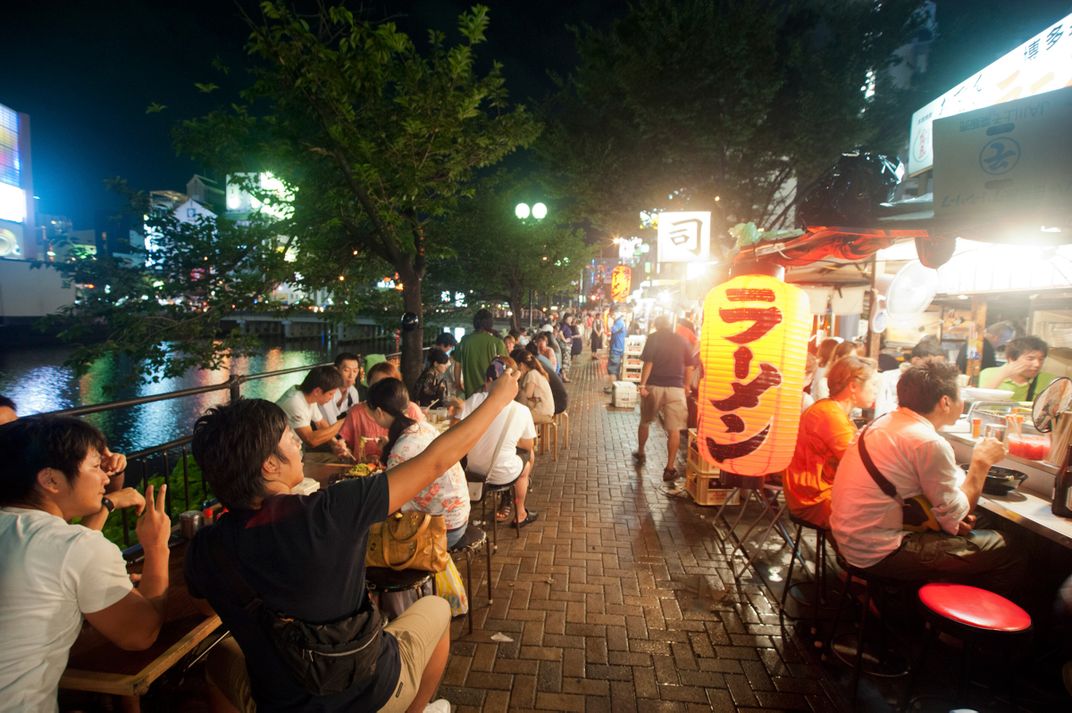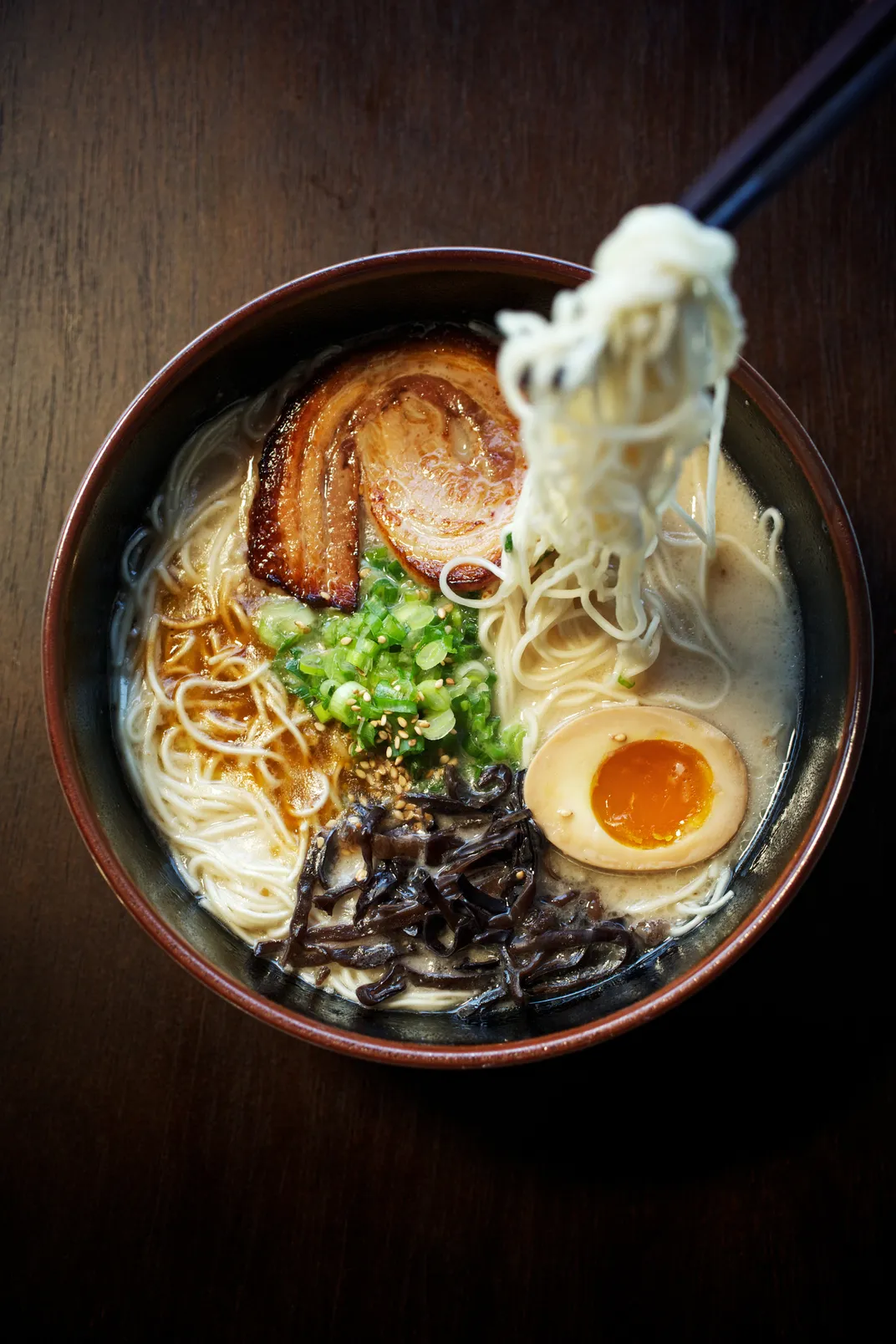You’ve Been Slurping Ramen All Wrong
In Japan, ramen is a culinary touchstone that goes way beyond food
:focal(2580x1006:2581x1007)/https://tf-cmsv2-smithsonianmag-media.s3.amazonaws.com/filer/74/d0/74d0fbcf-e9ad-4d2b-a200-19c34c1ef306/sqj_1701_aoe_ramen_02.jpg)
The proper position to eat ramen is with your face and hands at a certain angle and proximity to the bowl—close enough, and far enough away, to transfer noodles from bowl to mouth with chopsticks, and to let the aroma-infused steam deepen the sensory connection to the dish. The ramen noodle should be eaten al dente, but this creates a timing issue. Because it’s usually served in a hot broth, the noodle is prone to going soft. The quality of the experience hangs in the balance.
Hence the body positioning. Slurping also has a role. It helps cool the liquid, and aerates it, releasing a fuller expression of flavors.
“With the hot soup, it’s go go go: They say you have eight minutes in the soup before the noodle starts to overcook,” ramen expert Brian MacDuckston tells me. “You want to get your head right in there and stir it all up, activate the gluten.”
For the serious ramen eater, it’s a private communion more than a social experience. The most sought-after spots are the bar counters, and many restaurants are little more than bar counters. One place I visit has dividers that create cubicles reminiscent of old telephone banks, where I pass my order on a printed note through an opening only wide enough to receive back the bowl, as if human engagement would dilute the whole experience. Given the kitchen noise, the place is not as quiet as a library or a confessional booth, but the spirit of it suggests something similar. The etiquette around ramen includes one particular prohibition worth noting. Chopsticks need to be set down by the bowl or across its rim, never stuck into the noodles so that they point out at an upward angle, which is the way Japanese leave food offerings at graves and would be regarded as a gesture or symbol of death.
MacDuckston, who moved to Japan a decade ago from San Francisco, blogs about ramen shops, mostly those in Tokyo, and leads tours to his favorite spots. He figures there are at least 5,000 shops in Tokyo alone, though only about 200 to 300 make what he calls “impact ramen,” a certain sublime culinary level. In 2015, one of them, a nine-seat restaurant named Tsuta, became the first to earn a Michelin star. It was a distinguished moment in the history of ramen, a traditional street food elevated to an artisanal cuisine with gastronomique aspirations.
Ramen now reaches well beyond Japan. You can find shops in places as far away, geographically and culturally, as Iceland and Mexico, with chefs putting their own spin on the dish (e.g., Raheli’s Kosher Ramen Israeli style). In the case of the celebrated ramen chef Ivan Orkin, the first American to open a shop in Tokyo, passion for ramen has spun all the way back to Japan.
If ramen could yet turn out to be a fad in the rest of the world, its importance in Japan is hard to overstate. Tens of thousands of ramen shops dot the Japanese archipelago, and it’s a culinary and cultural touchstone that goes way beyond food—into modern history, popular culture, even, apparently, romance. The Ramen Bank, a website that scores ramen shops the way Wine Spectator scores wine, also offers a “ramen marriage hunting” service, a matchmaking link for those whose shared passion could be the foundation of a committed relationship.
Chefs travel to the country’s most remote recesses to source ingredients from farms and specialized makers of soy sauce and other products. At a top slurp shop, every ingredient is handcrafted, fermented, seasoned, smoked, chipped, or shaven for its role in the dish.

**********
Ramen soup is layered. Its base is an unseasoned stock—usually pork or chicken—and vegetables. The seasoning comes from a concentrated liquid called tare, which comes in three flavors: salt, miso, or soy. Each chef uses particular ingredients in specific proportions to make a signature tare, an often secret blend that distinguishes one shop from another. The noodles are made from wheat flour, salt, water, and baking soda, and their width or thickness should be calibrated to the consistency and flavor of the broth. A noodle has to stand up to the soup but not overwhelm it, so a thin noodle is usually for a subtle soup and a thicker one for a hearty soup. The dish is enhanced with aromatic oils and finished with toppings such as bonito or sardine flakes and garlic chips. Everything about ramen is about balance and harmony.
There are important regional differences. In Tokyo the stock is usually chicken and the amount of kansui, a baking soda compound in water that makes the ramen noodle different from, say, pasta, is comparatively high. Go west, and the Hakata style, tonkotsu, is pork-based. In the north and east, kansui is more concentrated, creating different styles of noodle.
A recent trend is yaki ramen, which is ramen without the broth. At the Raumen (Ramen) Museum in Yokohama—a modest-size mall of little ramen shops representing the various regional styles—one place features soupless ramen with tomato sauce and parmesan cheese, which to the uninformed might look like pasta and sauce. The difference is the noodle, which, because of the kansui, has a chewier texture and a distinctive smell. Japanese describe the pungent ramen odor in much the way cheese aficionados will make approving comparisons to barnyards and socks.
If the regional differences might be compared with variations of food in France or Italy, a notable difference is that Japan’s national food is not passed down by ancient tradition. For most of its history Japan’s basic grain was, of course, rice, not wheat; ramen only appeared in Japan in the 1880s, migrating from China. It was quick, cheap, and filling, and Japan began to adopt and fashion ramen as its own. But ramen really took root in Japan after World War II, and the reasons for that had less to do with culinary tastes than with political realities.
“There was an important geopolitical purpose behind the wheat that became Chuka soba [ramen noodles] and other foods, which was to stave off the rise of Communism in Japan,” writes George Solt in his engaging study, The Untold History of Ramen: How Political Crisis in Japan Spawned a Global Food Craze.
At the end of the war Japan was devastated; between bombings and drought, it was unable to feed itself. American authorities approached food policy somewhat punitively. Even though the American narrative was about magnanimity and big-heartedness, in fact the Japanese government was being charged the cost of the occupation. The Japanese were suffering, and Eisenhower wrote a memo to Truman warning that there could be violent unrest. After the communists took over China, in 1949, the Truman Administration expanded a policy that had become known as “containment.” It saw food aid as critical to rebuilding Japan and keeping the influence of the Soviets at bay. The U.S. dramatically increased the supply of wheat flour to Japan.
“The dependence on American wheat imports during the occupation set Japan on a long-term course of food importation that would set the stage for the flourishing of ramen...in later decades,” writes Solt. “The battle for Japanese hearts and minds would therefore occur in large part through food, making American wheat a highly effective public relations tool.”

**********
Slurping and noodling my way across Japan, I eventually arrive in Fukuoka on the northern edge of Kyushu Island. Here I learn firsthand another way in which the Second World War served to bolster the production and sale of ramen.
Fukuoka has a reputation as one of the world’s least known great food cities, and it is especially proud of its tonkotsu ramen, a rich, pungent pork-based style. And among its most popular attractions are yatai, or street stalls, especially the ones set up along the Naka River. The yatai, it turns out, are relatively new: They sprang up in the postwar period, at the end of Japan’s imperial era. Former colonists returning from China, Taiwan, and Korea established them because they were a quick and inexpensive way to get into business.
Today many yatai are two-man operations: a cook and a helper, who serves as a marketer and promoter to passersby still deciding which place to sample. Stools are set up at a counter around the cook, who passes out bowls and small plates as they’re ready.
Before I head out to sample Fukuoka’s ramen, I ask my hotel’s concierge to recommend a good yatai, along with directions. He dismisses them all as “touristy.” Not helpful, but no matter. It turns out none are so touristy as to have signboards in English or even Romaji (Japanese words in Roman lettering). I pick the one that has the longest wait for a seat.
Two Japanese women visiting from Tokyo befriend me and think I ought to try some things I neglected to order myself—the stalls also serve grilled meats—and pass me their small plates to pluck from. We manage to converse with some words in English and the miracle of a translation app. Other nearby seats are taken by a fellow American, a Swede, and a Frenchman. Perhaps because the beer and shochu flow—the Japanese custom is typically not to drink alcohol with ramen—this place is more social than some other slurp shops. Our gathering even begins to feel like an impromptu meet-up.
Some people may call the shop touristy. But I think it may say something about ramen, and how customs and tradition keep changing. Anyway, the food is very tasty and the atmosphere is fun. And at least I’m not completely lost: When it comes time to slurp, I’ve had a good week of training, and the one thing I do understand is how to get in just the right position.
Planning Your Next Trip?
Explore great travel deals
Smithsonian magazine participates in affiliate link advertising programs. If you purchase an item through these links, we receive a commission.